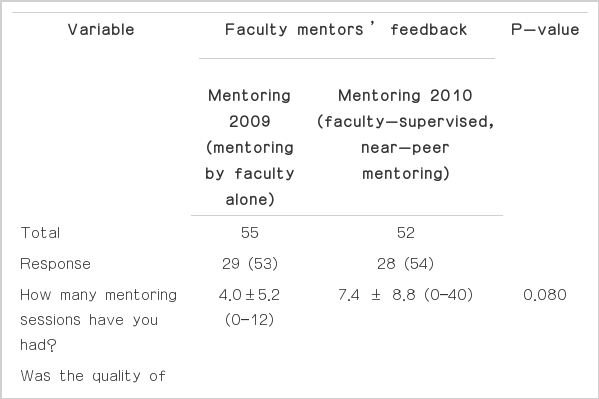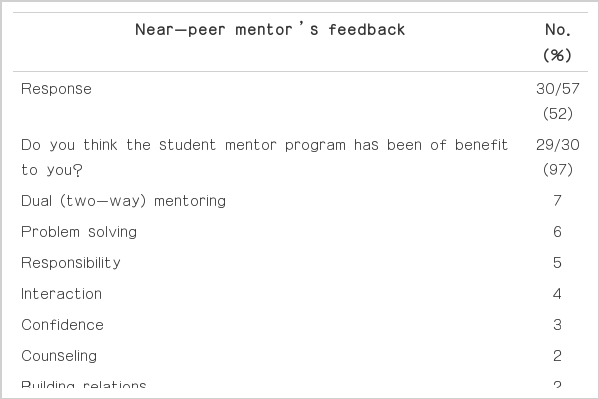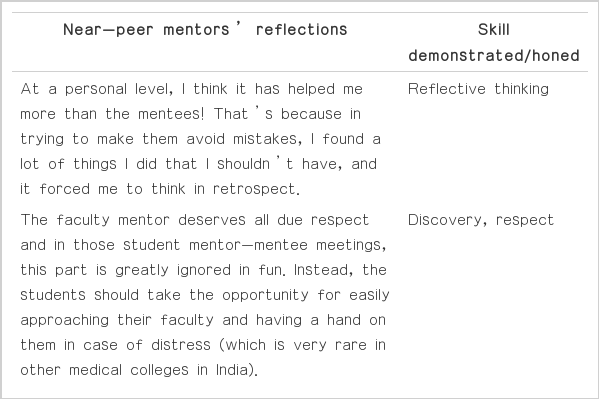Near-peer mentoring to complement faculty mentoring of first-year medical students in India
Article information
Abstract
Purpose:
The first year is stressful for new medical students who have to cope with curricular challenges, relocation issues, and separation from family. Mentoring reduces stress and facilitates adaptation. A program for faculty mentoring of first-semester students was initiated by the Medical Education Unit in 2009 at University College of Medical Sciences, Delhi. Feedback after the first year revealed that mentees were reluctant to meet their mentors, some of whom were senior faculty. In the following year, student mentors (near-peers) were recruited to see if that would improve the rate and quality of contact between mentees and mentors.
Methods:
Volunteer faculty (n=52), near-peers (n=57), and new entrants (n=148) admitted in 2010 participated in the ratio of 1:1:3. The program aims were explained through an open house meeting, for reinforcement, and another meeting was conducted 5 months later. At year-end, a feedback questionnaire was administered (response rate: faculty, 28 [54%]; mentees, 74 [50%]).
Results:
Many respondent faculty (27, 96%) and mentees (65, 88%) believed that near-peer mentoring was useful. Compared to the preceding year, the proportion of meetings between faculty mentors and mentees increased from 4.0±5.2 to 7.4±8.8; mentees who reported benefit increased from 23/78 (33%) to 34/74 (46%). Benefits resulted from mentors’ and near-peers’ demonstration of concern/support/interaction/counseling (35, 47.3% mentees); 23 mentees (82%) wanted to become near-peers themselves.
Conclusion:
Near-peer mentoring supplements faculty mentoring of first-year medical students by increasing system effectiveness.
INTRODUCTION
The first year is a stressful period for medical students; the new entrant has to cope with the challenges of the medical curriculum, a new environment, and anxiety of separation from family. Any form of support provided at this time could help. Mentoring has been shown to reduce stress and facilitate adaptation to change [1]. With this in mind, in 2009, the Medical Education Unit (MEU) of this Institute initiated a program in which volunteer faculty mentored first-year students [2]. The program, Mentoring 2009, randomly matched first-year students with a faculty mentor, and the latter’s role was to interact with and provide new students with an immediate support network. Evaluation of the program revealed that although some students felt supported, many were reluctant to meet their mentors, some of whom held high academic posts [2]. The suggestions received from students included the idea to recruit mentors from amongst senior students. They felt that new students would be less hesitant in sharing their difficulties with near-peers than with faculty.
Consequently, the MEU introduced near-peers into the existing scenario in 2010. Near-peer mentoring is a process in which an older or more able peer mentors a younger one [3]. The near-peer mentor, being close to the social, professional, or age level of the new student, may enhance his or her cognitive and psychomotor development [3]. The affective domain could also be expected to advance, as a trusting relationship with the near-peer, who does not hold a high academic post, might facilitate communication [4]. Also, the younger peer may find the skills of near-peers more achievable and easier to replicate [4,5]. The aim of this study was to evaluate near-peer mentoring of new medical students. Our hypothesis was that near-peer mentoring would improve the mentor-mentee contact rate and thus complement faculty mentoring of first-year undergraduate medical students.
METHODS
Fifty-two faculty mentors from the Mentoring 2009 program [2] volunteered as faculty mentors for 2010. A notice was posted describing the roles and responsibilities of near-peer mentors and seeking volunteers from students in their 3rd to 9th semesters. Fifty-seven near-peer students volunteered in writing and were recruited. All 148 first-year students admitted in 2010 (mentees) were randomly distributed across 52 groups each comprising one faculty mentor and one or more near-peer mentors. The ratio of faculty mentors to near-peer mentors to mentees amounted broadly to 1:1:3.
Mentees were informed through individual letters about the availability of the facility of mentoring, the do’s and don’ts of mentoring, and contact details of their faculty and near-peer mentors. The program commenced with an open house where mentees, near-peer mentors, and faculty mentors were invited and encouraged to get to know each other. The goals of mentoring, expectations of the program, and responsibilities of mentors were elaborated by one of the authors (UD). The gains of the inaugural mentoring program, perceived barriers, and recommendations were also discussed [2]. The presentation was followed by small-group meetings between mentees, near-peers, and faculty over refreshments, where ground rules for future meetings were set. It was left to the group to evolve as a team at their own pace. To encourage interaction, a second open house was held five months later, during which individual experiences were shared over refreshments and games. At the end of the year, mentors and mentees were requested to complete an open-ended questionnaire on their experience with the mentoring program. The questionnaire items were drawn from the following resources: (1) Planning Commission of British Columbia. Mentorship program evaluation form (cited March 28, 2014; available from: http://www.pibc.bc.ca/sites/default/files/pdfs/PIBC-Mentoring-Program-Evaluation-July2010.pdf); (2) Virginia Commonwealth University School of Medicine. Faculty Mentoring Guide (cited 2014 Mar 28; available from: http://www.medschool.vcu.edu/facultyaffairs/career_dev/facultymentoringguide/appendixa.html). The mentoring guide is available on the website of the Medical Education Unit. Available from: http://medicaleducationunit.yolasite.com/resources/A%20Guide%20to%20Mentoring%20Medical%20Students.pdf. Some had been used by the authors previously [2]. The quantitative and qualitative responses were descriptively analyzed and comprise the results of this study. SPSS ver. 17 (SPSS Inc., Chicago, IL, USA) was used for the statistical analysis, a chi-square test was used for categorical variables, and Student unpaired t-test for continuous variables.
RESULTS
Fifty-two faculty mentors, 57 near-peer mentors, and 148 mentees participated in Mentoring 2010. Though the faculty mentors reported that they had many more meetings with their mentees than in the previous year (Table 1), and they felt that more mentees benefited in the year that near-peer mentors were involved in the mentoring, the findings were not statistically significant. Mentees, on the other hand, met their near-peer mentors significantly more often than they did their faculty mentors (P=0.018) (Table 2). Both faculty mentors and mentees appreciated the contributions of near-peer mentors (Table 3). Near-peer mentors, too, gained valuable skills in the affective domain (Table 4). Their qualitative observations were recorded in Table 5.
DISCUSSION
The introduction of near-peer mentors into Mentoring 2010 seemed to improve contact between mentees and mentors, both quantitatively and qualitatively. There is limited research specifically addressing near-peer mentoring; most reports deal with faculty-student relationships [4]. Nevertheless, near-peer mentoring is not a new concept. Harvey Cushing’s relationship with William Osler is an early example; it is reported that they both benefited from the mentoring relationship [6]. Mentoring relationships have been reported to facilitate self-directed learning, career advancement, productivity, and a positive attitude towards another person’s (mentee’s) career [7-9]. Our study was able to identify specific benefits and difficulties with near-peer mentoring.
Near-peer mentoring: benefits to the mentee
As reported by new students, most measures of mentoring were comparable between faculty mentors and near-peer mentors (Table 2). The only reported difference was that mentees met more often with near-peers. Studies have shown that junior students reportedly prefer interacting and learning from near-peers because they are less intimidated by them than by their teachers [4]. Additionally, near-peers have recently passed through the same experiences and are, therefore, better able to understand the problems faced by new students [5,10]. The new students in this study, based on their qualitative feedback (Table 3), benefited academically, socially, and emotionally from having near-peer mentors. The benefits accruing to the mentee pertain to short-term goals of adjusting to the new and challenging academic environment. However, reports suggest that there are long-term advantages as well. Mentoring causes a ripple effect, and persons who have participated in mentoring as either mentees or mentors are more likely to mentor in the future [11]. The mentee is also more inclined to teach, to develop strong professional relationships, and to thus help in advancing the profession [4].
Advantages for the near-peer mentor
The near-peer mentors overwhelmingly felt that they benefited from being mentors (Tables 4, 5). Other studies have also shown that serving as a mentor enhances personal satisfaction, professional success, and organizational and professional contributions [12]. For the mentors in this study, benefits pertained mainly to the affective domain and occasionally to the cognitive and psychomotor domains. Student learning in the affective domain is often neglected in favor of the cognitive domain [13]; the results of this study reinforce our earlier findings that mentoring is a promising tool for honing medical students’ affective skills [2].
By reinforcing the near-peer mentor’s own knowledge, mentoring has been reported to hone teaching skills [3,14,15], a distinct advantage for medical students who are future residents and potential faculty members. Improvement in communication skills has also been reported as a result of mentoring activities; communication is an essential aspect of physician-patient interaction, and all efforts to enhance it would be welcome [16].
An unexpected benefit of our initiative was the two-way mentoring experienced by near-peers. Alongside their responsibilities of mentoring junior students, they were able to take advantage of the mentoring offered by faculty mentors. Thus, near-peers were both mentors and mentees; reportedly, they enjoyed the experience.
An advantage, as declared by the near-peers, was that near-peer mentoring, adequately supervised by faculty, bridged the gap between senior and junior students. The gap had widened since strict anti-ragging measures had made contact between senior and new students taboo for the first few weeks after admission. We took extreme care, through near-peer selection guidelines and through interviews and counseling, to ensure that near-peer mentoring was not used as a surrogate for ragging. Perhaps near-peer mentoring of first-year students may curb the menace of ragging, while allowing a healthy, mutually beneficial interaction between students at different levels of the hierarchy.
Barriers
Although more meetings took place during the period of this study, lack of time to meet was cited as a major barrier to mentoring. This was reported in our previous study [2], and it has troubled other mentoring endeavors as well [4,12]. Since common free time to meet is difficult to arrange owing to the hectic academic, patient care, and research schedules of the parties concerned, mentors must be enthusiastic about their roles. They must make extra effort to make themselves available and approachable [7]. The lack of initiative from mentees was troubling. The authors advise that the mentee must be proactive so as to receive the most benefit from the relationship [2,8]. In the inaugural meeting with new students, in order to make them aware of the concept of mentoring and of their role as mentees, we exhorted them to communicate with their mentors and apprised them of the availability of a mentoring guide on the MEU website (supplementary material B). This worked to a limited extent; perhaps mentees who did not get in touch did not feel the need for mentoring [2].
The close interpersonal relationship between mentor and mentee may sometimes blur ethical boundaries; however, the students in this study did not report any such issues. Perhaps the presence of faculty mentors in the equation helped. Further, the mentoring manual and open house meetings may have served to remind mentors about their roles and the need for high standards of role modeling.
Making mentoring work: the good mentor
Mentees appreciate mentors whose personal attributes include honesty and sincerity [17,18]; who have professional skills and abilities like leadership, social networking, and goal setting [4]; and who demonstrate good communication skills (listen actively), understand mentees’ needs, and resolve conflicts [4,18,19].
During the inaugural near-peer mentoring initiative at our institute, and based on mentees’ feedback, near-peer mentors exhibited several of the traits of a good mentor (Table 3). They were altruistic, understanding, patient, responsible, active listeners, motivating, accessible, problem solvers, teachers, and social networkers. They were also role models and good advocates for the mentoring program. Many (23; 82%) of the mentored first-year students wanted to be recruited as near-peer mentors for the following year’s entering class.
Facilitated mentoring
Mentoring models can range from completely formal to completely informal, with various permutations in between. Since we did not employ match-making or have structured training for mentors, ours was not a truly formal mentoring program; however, we did formally assign mentors, set up meetings according to a schedule, and have an evaluation process facilitated by the program organizers; hence, the mentoring model was a facilitated, partly formal one. Advocates of mentoring have suggested that the type of mentoring depends on the institution’s needs and experiences [4]. We anticipated that new students would have insufficient knowledge of and exposure to their seniors or the faculty, and limited access to them; hence, self-selection of mentors would be impractical [7]. Thus, we chose formal allocation of mentors rather than self-selection. Assigned mentoring has been criticized because there may be a lack of chemistry, and the relationship may feel forced [18,19]. Such concerns were recorded by a few of our participants, who quoted non-compatibility as having a negative impact on the mentoring process; nevertheless, feedback revealed that effective mentoring occurred despite such difficulties, suggesting that successful mentoring can develop even through formal assignment of mentors. Success depends greatly on the individuals involved [19].
Limitations
The study, being questionnaire based, may have been subject to response bias. Perhaps non-respondents had a different experience with their near-peer mentors. Thus, the positive experiences reported by the respondents may be an overestimation; nevertheless, the response rate of around 50% is much better than that reported in the literature, giving credence to our findings [4]. Further, since near-peer mentoring was being implemented at this university for the first time, the sample included only one student cohort, resulting in a small sample size; thus, our experiences with near-peer mentoring may not be representative of other institutes in India, or elsewhere in the world where near-peer mentoring is also being practiced.
Future directions
The success of near-peer mentoring depends on students being prepared for the job [11]. The authors recommend that students be trained in the fundamentals of mentoring and that faculty be readily available to provide support. Preparedness leads to better experiences and more effective mentoring [11]. To maximize the benefits for new students, we plan to implement an enhanced near-peer mentor training program prior to the admission of the next cohort of first-year medical students. Perhaps incentives for near-peers in the form of institutional acknowledgment and letters of commendation may help optimize mentor performance. Further, we plan to encourage asynchronous online mentoring practices through e-mail and social networking sites since such media has been found to appeal to contemporary students [20]. In order to provide a support system for low-achieving students, the program will be directed to identifying them early in the course and applying remedial measures as appropriate.
In conclusion, mentoring is a dynamic process, and program evaluation is essential. Feedback can provide an impetus for evolution and can enhance the success of the program. The feedback in this study reveals that near-peer mentoring supplements faculty mentoring of first-year medical students. We believe that, in a fostering environment, near-peer mentors have the diverse abilities required to provide effective mentoring. Mentors, in turn, benefit by honing or acquiring various skills critical for the development of a humane doctor.
Notes
CONFLICT OF INTEREST
No potential conflict of interest relevant to this article was reported.
Acknowledgements
We would like to acknowledge the mentors (faculty and near-peers) and mentees for participating in this program. This project was part of a curriculum innovation project for the Foundation for Advancement of International Medical Education Research (FAIMER) fellowship of one of the authors (SS), and he acknowledges the contribution of faculty and 2011 fellows at FAIMER Regional Institute, Ludhiana. The abstract was presented as a poster at the South East Asian International and Indian National Conference on Health Professions Education, 2012 (SEARAME NCHPE 2012) at PSG Institute of Medical Sciences & Research, Coimbatore, India, September 5–8, 2012.
SUPPLEMENTARY MATERIAL
Audio recording of the abstract.





